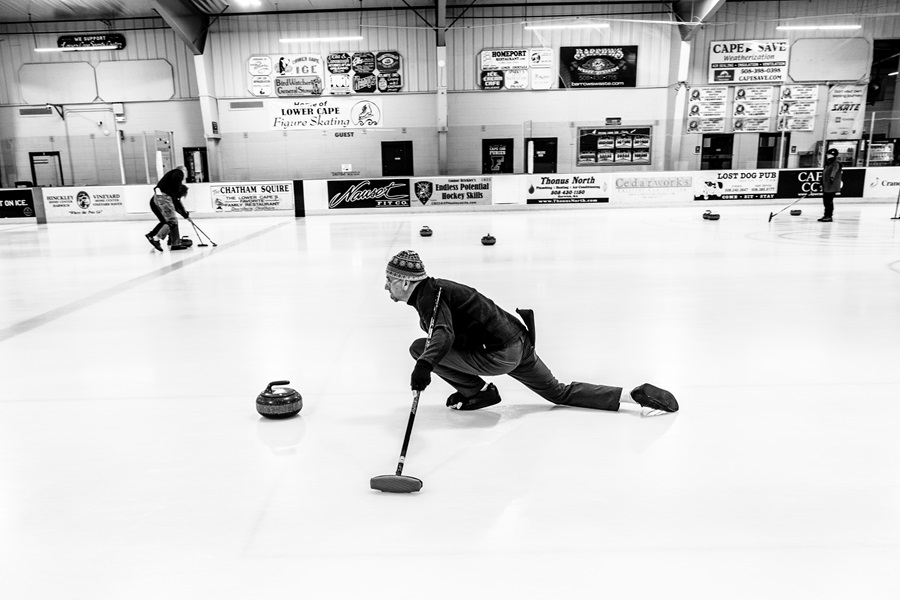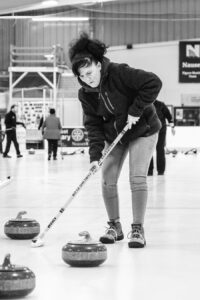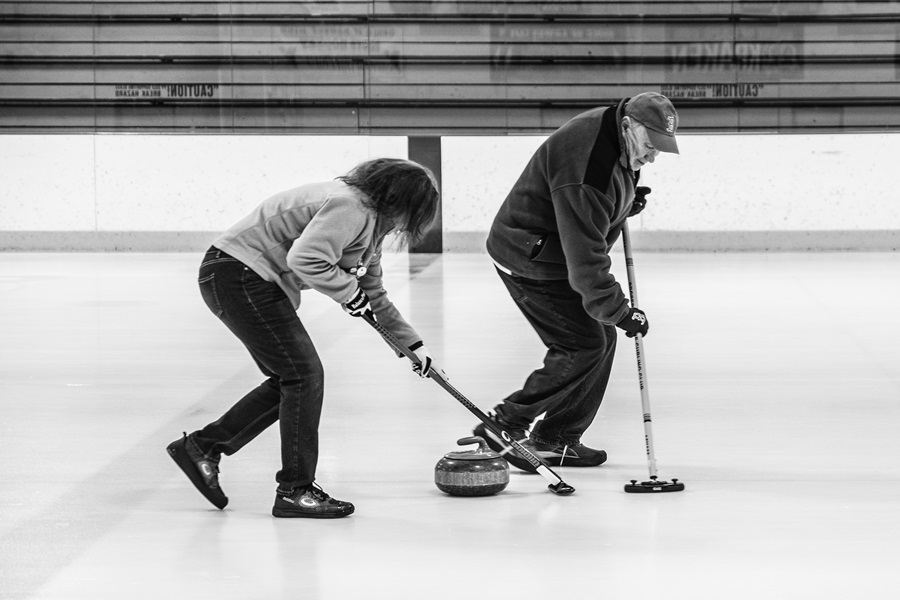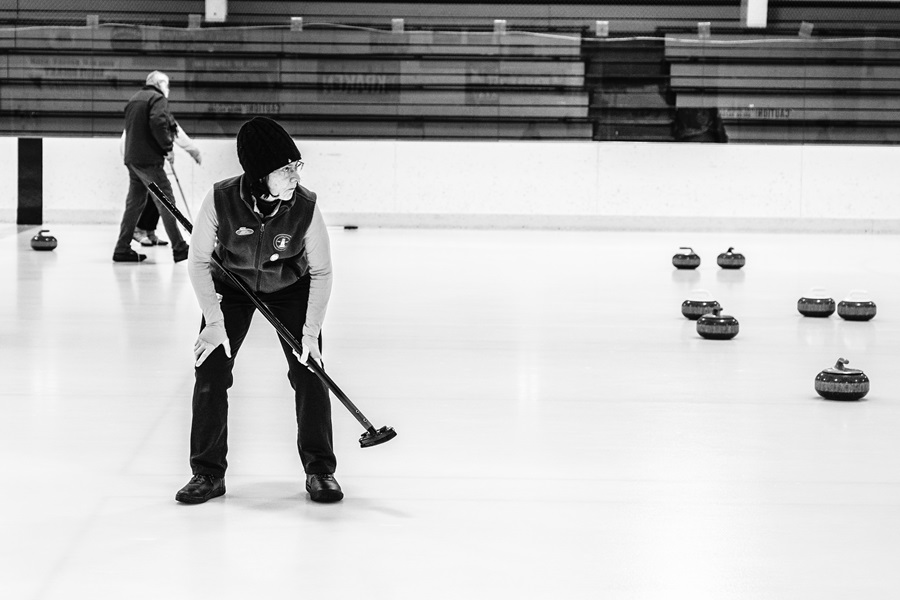ORLEANS — The third part of the answer to the Sphinx’s riddle for Oedipus was on view, with a twist, at Charles Moore Arena in Orleans on Jan. 5, where humans navigated the ice on two legs plus brooms, sticks, and stabilizers. The 32 curlers, some in T-shirts, others bundled in insulating layers, gathered to throw polished granite stones across the freshly pebbled ice.
It was the opening night of the 2025 winter session of the Lower Cape Curling Club (LCCC), a 10-week adventure in strategy and camaraderie.
“This is the first league night that we’ve used all four sheets,” said Thom Freytag, club president and Chatham resident, referring to the side-by-side 46-by-5-meter-ish rectangles akin to courts where matches are played. That milestone reflects steady growth for the club in recent years. It now has 59 members and eight associate members hailing from Sandwich to North Truro and divvied up over two weekly sessions.

The club claims ice time at the Charles Moore rink on Wednesdays from 10 a.m. to noon and Sundays from 4:30 to 6:30 p.m. Seven newcomers were among the group learning the ropes — or rather, the stones, on Sunday.
For the uninitiated, curling might seem like a chilly cousin of bowling or bocce. It originated in Scotland, with references to the game played on frozen lochs or ponds found as early as the 16th century, according to a history of the sport by its governing body, World Curling.
In 1838, the Grand Caledonian Curling Club in Edinburgh formalized the sport with rules, and during the 19th century, curling spread where Scots settled, from New Zealand to Sweden to Canada and the U.S. It made its Olympic debut in Chamonix, France in 1924 as a “demonstration sport” and became a medal event at the 1998 Olympics in Nagano, Japan.
Curlers slide 42-pound stones across the sheet aiming for the “button” or center of a large target called the “house.” Teams of four take turns delivering the stones, while two teammates “sweep” the ice to influence the stone’s speed and direction.
The objective is simple: get the stone as close to the house’s center as possible. But execution is another story. The sliding motion and a bit of bad luck can make it deceptively complex, as this reporter, with rubber grippers on her shoes, learned on Dec. 15 during a packed “learn to curl” session at the arena.

The final league games of the fall session buzzed on adjacent sheets as member Bill Shinnick, with help from Ron Fancy, Marty Rebhum, Bridget Murphy, and others, guided newcomers through the basics.
“It’s harder than it looks,” said Wendy Walker, a Harwich resident and first-time curler. “There are a lot of subtleties.” Her husband, Doug, was also there, inspired by watching the Olympics.
First, the stance: right foot in the “hack,” a starting block set up on the ice, feet aligned like a sprinter at the starting line. The right hand grips the stone’s handle, while the left is steadied on a stabilizer — a molded plastic platform players push against for balance. The handle is oriented like clock positions, with the 10 o’clock and 2 o’clock positions leading down the ice toward the “skip’s” extended hand (the skip being, essentially, the team captain).
Next, the delivery: push the stone slightly forward, draw it back, and finally, lunge forward with a controlled slide. The goal is to release the stone before crossing the “hog line,” which is 10 meters from the hack, ensuring a smooth trajectory toward the skip’s target.
“You release at 12 o’clock,” said Shinnick. Once the stone is released, the thrower keeps walking. A dead stop could result in a fall.
“The speed and direction come from the pushing leg,” said Shinnick. “You give the stone a little bit of a push, but it’s not a shove.”

Sweeping extends a stone’s run by reducing friction on the ice. Players jog beside the stone, sweeping with vigor while the skip directs traffic. “Burning” the stone means someone sweeping has accidentally touched it. In that case, it is taken out of play.
“The first few rocks of any game, you’re reading the ice,” said Murphy, who skippered an all-women’s team during the fall session.
“It’s like playing golf,” added Freytag. “Every time your ball is on the green, you’re looking at the conditions.”
It was Ron Fancy who founded the LCCC in 2018, with help from former U.S. Curling Association president Evelyn Nostrand. Since then, the club has carved out a niche as a welcoming space for curling enthusiasts on Cape Cod — even those who’ve never curled before.
“New players are tentative,” said Freytag, who first encountered curling in the 1970s while tending bar at the Utica Curling Club in Utica, N.Y. but began curling in earnest only after joining LCCC in 2018. Their nerve increases quickly: “Once you’re out there on the ice, seeing people deliver the stone, it’s a pressure situation,” said Freytag.

Each LCCC session begins with a draft to form new teams, ensuring a mix of skill levels in filling out the lead, second, and vice skip positions. Skips are responsible for strategy and must select at least one newcomer. Over the 10 weeks, curlers get about 20 hours on the ice, competing each week in eight 15-minute “ends,” or rounds, per game and throwing eight stones during each end.
League nights conclude with “broomstacking,” a curling tradition where players socialize and rehash the game. At Charles Moore Arena, this often means trays of brownies or cookies in the warm room rather than the drink-buying customs of other clubs. In many, the winning team buys the losing team drinks, a gesture that is soon reciprocated.
Curling’s appeal lies in its blend of strategy, physicality, and accessibility. For newcomers, there is the thrill of landing a stone in the house for the first time. For veterans, there are plenty of subtleties to master. While some members travel to “bonspiels,” or competitive tournaments, many simply savor the camaraderie of weekly games on home ice.
As the night drew to a close, the dull crack of stones colliding echoed across the arena, punctuated by barks of “Sweep!” and “Up!” and “Let it go!”
For this reporter, the experience offered a glimpse into a sport that is less about perfection than persistence, its repetition offering a meditation on balance, which might be useful on ice and otherwise. The evening ended with a lesson in preparation: next time, warmer socks.



